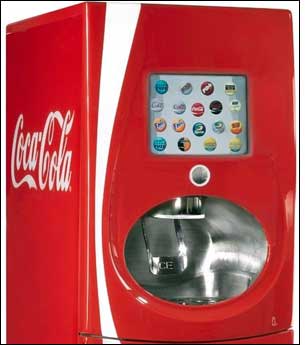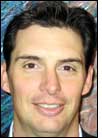Coca-Cola has begun beta-testing an RFID-enabled drink dispenser that the company claims will transform the soft drink dispensing industry, by providing more than 100 drink options from a single machine. The machine, known as Freestyle, utilizes RFID technology to identify 30 or more cartridges, determine the quantity of flavoring inside each, and transmit data back to Coca-Cola indicating which drinks are being consumed, and when.
“We consider Freestyle nothing short of a revolution in the fountain dispenser business,” says Ray Crockett, Coca-Cola’s director of communications. The system not only offers consumers a vast choice of Coca-Cola beverages, he notes—from sodas to flavored waters—it also provides the company with real-time insight into what is happening in restaurants across the United States.
The Freestyle system, in design for several years, also uses RFID to ensure each cartridge is being installed properly, to guarantee it is not counterfeit, and to instantly stop the dispensing of certain drinks if Coca-Cola needs to recall the cartridges or their contents necessary to produce that beverage, says Gene Farrell, VP of the company’s JET Innovation Program team, which developed the technology.
When developing the system’s technology, Coca-Cola considered several options that would help the firm track its beverage cartridges. Each drink consists of a mix of several ingredients. A Coke selection, for example, includes concentrated flavorings from a cartridge, a sweetener (such as corn syrup), water and carbonation. When an order is selected at the machine, the appropriate mix of all those elements is then injected into the customer’s cup.
The cartridges are the key to the large drink selection, however, and tracking those cartridges—ensuring they are not incorrectly placed or depleted—is thus essential to the machine’s success. While the JET Innovation Program team considered placing bar-coded labels on each cartridge, Farrell says, bar coding had several limitations. First, it would have required the servicing staff to scan each label with a bar-code reader before installing it in the machine. “It would mean an added step for the crews,” Farrell says. In addition, with bar codes, the machine would not have had the ability to read and write data regarding cartridge use in such a way that it could be stored with that particular cartridge and follow it, or be updated as needed. “With RFID,” he states, “we have the ability to leverage a write-back feature.”
When a cartridge is manufactured and filled at the Coca-Cola plant, Farrell says, it is fitted with a passive RFID tag. (He declines to reveal the tags’ frequency or RFID standard, citing trade secrets.) An interrogator at the manufacturing site then writes data onto the tag, such as details about the drink in the cartridge, as well as the volume.
When a cartridge is installed in the Freestyle dispenser, the individual servicing that dispenser holds it up to the machine, and an RFID interrogator captures the unique ID number and other data encoded to the cartridge tag. If the machine’s onboard computer confirms that the cartridge’s ID number is valid, it releases the door lock and illuminates an LED light at the location at which the cartridge should be installed. The employee then opens the door and removes the empty cartridge from the slot where the LED light is shining, replacing it with a new one. An RFID interrogator inside the machine captures the tag’s unique ID as the new cartridge is installed; if that cartridge is being placed in the wrong slot, the machine will fail to operate.
According to Farrell, a single Freestyle dispenser contains multiple RFID interrogators, though he declines to reveal the exact number. The RFID infrastructure was one of the system’s harder components to develop, he says, and a trade secret Coca-Cola is protecting from competitors. “There was a lot of genius behind figuring out how to read each tag without cross-reads in a very tight space,” he states, adding that there are several patents pending on Coca-Cola’s design.
To select a drink, a consumer uses a touch screen on the front of the machine to indicate the desired beverage. The dispenser’s interrogators can then write usage-related data to the tag each time a particular cartridge is used, thereby enabling the system to calculate the remaining amount of that cartridge’s contents.
What’s more, the machine provides Coca-Cola with business analytics, as it has both cellular and cabled Ethernet network capability, thus enabling it to communicate with the beverage maker’s Freestyle SAP data-management system in Atlanta. The machines can upload data indicating which beverages are being consumed most, at what times and in what places, Farrell says, and the dispensers can also receive directives from the network. If a cartridge with a particular tag ID number needs to be recalled, for instance, the network can instruct the machine to stop dispensing any beverages made with contents from that specific cartridge.
Coca-Cola also plans to employ the RFID tags for supply chain management, Farrell says. At the packaging site, RFID interrogators can verify that each box contains the correct beverage cartridges before it is shipped. The technology may also be utilized for a recycling program in which the cartridge tags could be read as they are shipped to recycling plants—though such a system, he notes, is not yet in place. “Once we made the decision to use RFID, we decided to leverage it as much as possible,” he states. “Since we have that capability, we might as well use it.”
To date, two machines are being tested in fast-food restaurants in Atlanta, and three states (California, Georgia and Utah) have been identified where the company will roll out approximately 60 dispensers by the end of this summer. If the system is a success, Coca-Cola plans to introduce it across the country. “To accomplish any big breakthrough such as this one, we have to take the approach of learning as we go,” he says, indicating that the company intends to study the results of the initial beta tests before making any concrete plans.



